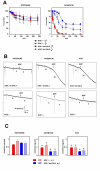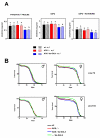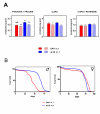Mitochondrial ROS production correlates with, but does not directly regulate lifespan in Drosophila
- PMID: 20453260
- PMCID: PMC2880708
- DOI: 10.18632/aging.100137
Mitochondrial ROS production correlates with, but does not directly regulate lifespan in Drosophila
Abstract
The Mitochondrial Free Radical Theory of Aging (MFRTA) is currently one of the most widely accepted theories used to explain aging. From MFRTA three basic predictions can be made: long-lived individuals or species should produce fewer mitochondrial Reactive Oxygen Species (mtROS) than short-lived individuals or species; a decrease in mtROS production will increase lifespan; and an increase in mtROS production will decrease lifespan. It is possible to add a further fourth prediction: if ROS is controlling longevity separating these parameters through selection would be impossible. These predictions have been tested in Drosophila melanogaster. Firstly, we studied levels of mtROS production and lifespan of three wild-type strains of Drosophila, Oregon R, Canton S and Dahomey. Oregon R flies live the longest and produce significantly fewer mtROS than both Canton S and Dahomey. These results are therefore in accordance with the first prediction. A new transgenic Drosophila model expressing the Ciona intestinalis Alternative Oxidase (AOX) was used to test the second prediction. In fungi and plants, AOX expression regulates both free radical production and lifespan. In Drosophila, AOX expression decreases mtROS production, but does not increase lifespan. This result contradicts the second prediction of MFRTA. The third prediction was tested in flies mutant for the gene dj-1beta. These flies are characterized by an age-associated decline in locomotor function and increased levels of mtROS production. Nevertheless, dj-1beta mutant flies do not display decreased lifespan, which again is in contradiction with MFRTA. In our final experiment we utilized flies with DAH mitochondrial DNA in an OR nuclear background, and OR mitochondrial DNA in DAH nuclear background. From this, Mitochondrial DNA does not control free radical production, but it does determine longevity of females independently of mtROS production. In summary, these results do not systematically support the predictions of the MFRTA. Accordingly, MFRTA should be revised to accommodate these findings.
Conflict of interest statement
The authors of this manuscript have no conflict of interest to declare.
Figures






Similar articles
-
The mitochondrial free radical theory of aging: a critical view.Curr Aging Sci. 2008 Mar;1(1):10-21. doi: 10.2174/1874609810801010010. Curr Aging Sci. 2008. PMID: 20021368
-
Regulation of lifespan by the mitochondrial electron transport chain: reactive oxygen species-dependent and reactive oxygen species-independent mechanisms.Antioxid Redox Signal. 2013 Dec 1;19(16):1953-69. doi: 10.1089/ars.2012.4900. Epub 2012 Oct 11. Antioxid Redox Signal. 2013. PMID: 22938137 Review.
-
Mitochondrial reactive oxygen species: Do they extend or shorten animal lifespan?Biochim Biophys Acta. 2016 Aug;1857(8):1116-1126. doi: 10.1016/j.bbabio.2016.03.018. Epub 2016 Mar 17. Biochim Biophys Acta. 2016. PMID: 26997500 Review.
-
Regulation of longevity and oxidative stress by nutritional interventions: role of methionine restriction.Exp Gerontol. 2013 Oct;48(10):1030-42. doi: 10.1016/j.exger.2013.02.021. Epub 2013 Feb 27. Exp Gerontol. 2013. PMID: 23454735 Review.
-
Production and scavenging of reactive oxygen species both affect reproductive success in male and female Drosophila melanogaster.Biogerontology. 2021 Aug;22(4):379-396. doi: 10.1007/s10522-021-09922-1. Epub 2021 Apr 26. Biogerontology. 2021. PMID: 33903991 Free PMC article.
Cited by
-
Resveratrol attenuates hydrogen peroxide-induced aging through upregulation of autophagy in human umbilical vein endothelial cells.Drug Des Devel Ther. 2019 Feb 22;13:747-755. doi: 10.2147/DDDT.S179894. eCollection 2019. Drug Des Devel Ther. 2019. PMID: 30863014 Free PMC article.
-
Mitohormesis: Promoting Health and Lifespan by Increased Levels of Reactive Oxygen Species (ROS).Dose Response. 2014 Jan 31;12(2):288-341. doi: 10.2203/dose-response.13-035.Ristow. eCollection 2014 May. Dose Response. 2014. PMID: 24910588 Free PMC article.
-
dj-1β regulates oxidative stress, insulin-like signaling and development in Drosophila melanogaster.Cell Cycle. 2012 Oct 15;11(20):3876-86. doi: 10.4161/cc.22073. Epub 2012 Sep 14. Cell Cycle. 2012. PMID: 22983063 Free PMC article.
-
Age-related ceRNA networks in adult Drosophila ageing.Front Genet. 2023 Feb 28;14:1096902. doi: 10.3389/fgene.2023.1096902. eCollection 2023. Front Genet. 2023. PMID: 36926584 Free PMC article.
-
Erinacine A-enriched Hericium erinaceus mycelia promotes longevity in Drosophila melanogaster and aged mice.PLoS One. 2019 May 17;14(5):e0217226. doi: 10.1371/journal.pone.0217226. eCollection 2019. PLoS One. 2019. PMID: 31100095 Free PMC article.
References
-
- Linnane AW, Kios M, Vitetta L. Coenzyme Q(10)—its role as a prooxidant in the formation of superoxide anion/hydrogen peroxide and the regulation of the metabolome. Mitochondrion. 2007;7:S51–S61. - PubMed
-
- Sanz A, Stefanatos R. The Mitochondrial Free Radical Theory of Aging: a critical view. Current Aging Science. 2008;1:10–21. - PubMed
-
- de Magalhaes JP, Church GM. Cells discover fire: employing reactive oxygen species in development and consequences for aging. Exp Gerontol. 2006;41:1–10. - PubMed
-
- Sanz A, Pamplona R, Barja G. Is the mitochondrial free radical theory of aging intact. Antioxid Redox Signal. 2006;8:582–599. - PubMed
Publication types
MeSH terms
Substances
LinkOut - more resources
Full Text Sources
Medical
Molecular Biology Databases

